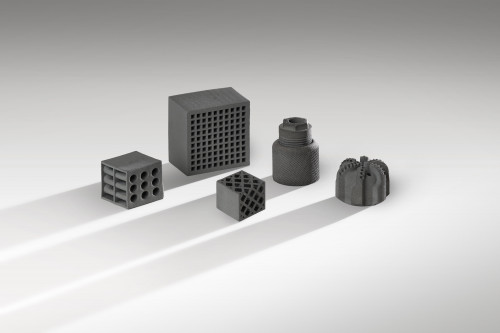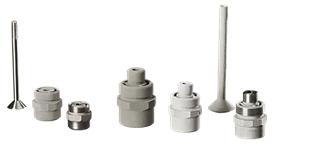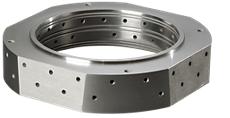Kennametal has launched its KAR85-AM-K, tungsten carbide for binder jetting. The material, which is comparable to its existing CN13S Co-Ni-Cr powder, is tough, hard-wearing and ideal for wear-resistant parts and surfaces. The grade has been designed to be more corrosion-resistant than its competitors. You can now order binder jetted parts in the material from Kennametal.
The company is already testing components in the field with customers and states that it can achieve “fully densified, corrosion resistant components that meet or exceed the properties of conventionally manufactured carbide components.”

Jay Verellen, General Manager, Kennametal Additive Manufacturing, stated, “Kennametal is leading the way in tungsten carbide additive manufacturing by combining the superior wear and corrosion resistance of our new KAR85-AM-K grade with deep expertise in binder jet 3D printing. With this new grade, we’re delivering the best of both worlds for our customers—the highly desirable material properties of conventional tungsten carbide with the design flexibility of additive—for high performance components that go the distance in the most demanding applications.”

Stellite components made by Kennametal
The company already offers hard-wearing components through binder jet in Stellite. Binder jet is often touted as the next big thing, but it is exceedingly difficult today to order a binder jet part from a service. This has to do with a lack of process control and low repeatability, as well as difficulty in compensating for shrinkage in novel parts.
So, Kennametal diving deep into binder jet to offer an integrated solution that produces parts for industry is welcomed. Interestingly, metal binder jetting pioneer ExOne was formed when it sold its non-3D printing business to Kennametal in 2005. The comparatively low-cost structure of binder jet coupled with high performance parts could see the company gain an early lead on other entrants, specifically in binder jetting wear-resistant parts. Other firms such as Belgium’s LCV already offer Stellite and other hard-wearing materials through laser cladding, which allows you to economically resurface (comparatively, for us) large parts, as well as make new parts. But, binder jetting hard wearing components is a rather new concept in the commercial world. Hard facing parts represents a very specific, but considerable industry.

A 3D Printed Stellite valve
From excavator buckets to saw blades, valves, and cutting tools, Stellite and other hard-facing materials help industries run smoother for longer. Less interruptions, less maintenance, and fewer replacement parts in the most demanding applications are important results. Highly temperature-resistant, as well as wear-resistant, these materials have been an important addition to the engineer’s arsenal. But, traditionally these super hard materials were, of course, super difficult to machine, as well. This meant that components were expensive or took a long time to make. Now, with 3D printing, Kennametal can make its abrasion resistant parts with less difficulty.
Kennametal is a $2.4 billion revenue company with over 10,000 employees. It didn’t make a huge and showy entrance into AM, but rather quietly and surely built an end-to-end solution that no one else has. Kennametal’s offering of powders and manufacturing experience poises it to win in its hard facing market segment.
Contrast the firm’s service based market entry with that of fellow travelers Oerlikon, Sandvik and GF. Oerlikon also developed powders and is working on building its space and aviation business in additive. Through BEAMIT, Sandvik seems to want to acquire one of the largest service businesses in AM while GF has partnered with 3D Systems to offer machining solutions in tandem with their technology.
While Oerlikon wants to go deep in expertise in a much coveted market segment, Kennametal has chosen something decidedly less sexy. Sandvik is spending big to acquire customers, certifications, and revenue. If it can keep it up, the company could roll up more services and become the number one service worldwide. I think that this is an ambitious but exciting plan for a materials company. To go from being a leader in metal to lead in AM components is very tempting, but, a roll-up of services could be very expensive, especially with all sorts of SPACs on a spending spree. GF may well be onto something with a deep integration with a partner, but it is very dependent on 3D Systems. Kennametal’s approach is comparatively soft, but the firm is working on developing a service that could lead the hard facing world in 3D printing for years to come.
Subscribe to Our Email Newsletter
Stay up-to-date on all the latest news from the 3D printing industry and receive information and offers from third party vendors.
You May Also Like
Profiling a Construction 3D Printing Pioneer: US Army Corps of Engineers’ Megan Kreiger
The world of construction 3D printing is still so new that the true experts can probably be counted on two hands. Among them is Megan Kreiger, Portfolio Manager of Additive...
US Army Corps of Engineers Taps Lincoln Electric & Eaton for Largest 3D Printed US Civil Works Part
The Soo Locks sit on the US-Canadian border, enabling maritime travel between Lake Superior and Lake Huron, from which ships can reach the rest of the Great Lakes. Crafts carrying...
Construction 3D Printing CEO Reflects on Being Female in Construction
Natalie Wadley, CEO of ChangeMaker3D, could hear the words of her daughter sitting next to her resounding in her head. “Mum, MUM, you’ve won!” Wadley had just won the prestigious...
1Print to Commercialize 3D Printed Coastal Resilience Solutions
1Print, a company that specializes in deploying additive construction (AC) for infrastructure projects, has entered an agreement with the University of Miami (UM) to accelerate commercialization of the SEAHIVE shoreline...





























